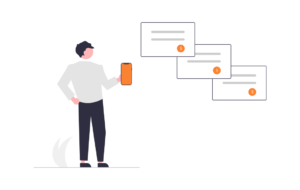Table of content

Overview
Free mobile apps can make money through several strategies. In-app advertising is popular, where developers earn by displaying ads within the app. In-app purchases allow users to buy virtual goods or unlock premium features. The freemium model offers basic features for free while charging for advanced functionalities. Subscription services provide ongoing content for a recurring fee. Sponsorships and partnerships can also bring in revenue by collaborating with brands. Finally, selling user data (with consent) is another controversial yet profitable method.
When considering these options for your mobile app, evaluate your target audience, app functionality, and long-term goals. Balancing user experience with monetisation strategies is crucial to maintaining engagement and ensuring sustainable revenue growth.
In-App Purchases: The Leading Revenue Driver

In-app purchases (IAPs) are one of the main ways free mobile apps make money, especially in the gaming industry. IAPs allow users to unlock additional features, content, or virtual goods.
IAPs take various forms, including consumable, non-consumable, and subscriptions. Consumable IAPs are one-time purchases of virtual items that can be used up, such as extra lives or in-game currency. Non-consumable IAPs involve permanent unlocks like removing ads or accessing premium features. Subscription-based IAPs offer users access to premium content through recurring payments.
Apps like Spotify, Netflix, and Dropbox leverage this model effectively. “Candy Crush Saga,” a mobile game, allows players to purchase extra lives, boosters, and in-game currency, proving incredibly lucrative. Another example is Tinder, which offers subscriptions for premium features.
IAPs provide continuous revenue, allowing developers to monetise over an extended period. They offer a free entry point, reducing barriers to app adoption and catering to varying user preferences.
Advertising: A Delicate Balance

Advertising is another prevalent way for free apps to make money. By displaying ads within the app, typically as banner ads, interstitial ads, video ads, or native ads.
While profitable, developers must balance monetisation and user experience. Intrusive ads can frustrate users and lead to app abandonment.
To maximise ad revenue while minimising disruption, developers use ad networks and mediation platforms. Ad networks like Google AdMob and Facebook Audience Network connect developers with advertisers. Mediation platforms like AdMob Mediation and ironSource optimise ad monetisation by serving high-paying ads from multiple networks.
Effective ad implementation involves careful ad placement, frequency, and targeting. Analytics tools help identify optimal placements and frequencies. Targeted ads improve relevance, enhancing user experience.
Successful ad monetisation requires balancing revenue generation with a positive user experience. Integrate ads carefully, use mediation platforms, and continuously optimise strategies based on feedback and data.
Freemium and Subscription Models
The freemium model offers a basic app version for free while charging for premium features or additional content. This approach allows users to experience core functionality without upfront costs, potentially leading to higher adoption rates.
Spotify is a successful example, offering a free ad-supported tier and a premium version with additional benefits. Subscription models require users to pay a recurring fee to access full features and content, common in productivity and streaming apps.
Freemium apps benefit from widespread adoption and converting free users to paid customers. Striking the right balance between free and premium features can be challenging. Subscription models offer predictable revenue but may face higher initial barriers to user acquisition.
The choice between models depends on the app’s use case, target audience, and perceived value proposition. Some apps combine both models, offering a free tier, paid upgrades, and recurring subscriptions.
Leveraging User Data and Analytics
Leveraging user data and analytics unlocks the true monetisation potential of apps. Collecting and analysing user data provides insights into behaviour, preferences, and engagement patterns, helping optimise strategies.
Apps can collect data on demographics, app usage, in-app events, and purchase history. This data enables user segmentation, identification of high-value users, and personalisation of the app experience.
Personalised in-app purchases and targeted ads can enhance user experience and increase monetisation success. Ethical data practices and respecting user privacy are crucial to maintaining trust and compliance.
Using data responsibly allows apps to optimise monetisation strategies, deliver personalised experiences, and foster long-term user engagement, driving sustainable revenue growth.
Partnerships and Sponsorships

Partnerships and sponsorships can offer lucrative ways for free apps to make money. Collaborating with brands provides new income while adding value to users.
Branded content, product placements, and sponsored features seamlessly integrate brands into app experiences. Influencer marketing leverages popular influencers to promote in-app purchases and subscriptions.
Successful partnerships include branded content in mobile games and fitness apps partnering with sportswear brands for exclusive content. Select brand partners align with the app’s audience and values, maintaining user trust.
Partnerships, when balanced well, benefit apps, brands, and users alike, offering additional revenue and enhancing user experience.
Emerging Monetisation Strategies
New technologies and changing user behaviours are driving innovative strategies for free apps to make momey.
Blockchain and cryptocurrency integration facilitate micro-transactions and digital asset ownership. Augmented reality (AR) and virtual reality (VR) offer premium content, virtual item sales, and sponsored experiences. Artificial intelligence (AI) personalises monetisation through targeted ads, personalised in-app purchases, and dynamic pricing adjustments.
Apps are also exploring “pay what you want” models and social monetisation, enabling users to earn rewards by promoting the app or participating in community activities.
Staying ahead of trends and leveraging new technologies allows developers to unlock novel revenue streams.
Ethical Considerations and User Trust
Maintaining ethical practices and user trust is crucial. Transparent data policies, clear consent mechanisms, and robust data protection measures are essential.
Deceptive tactics for encouraging in-app purchases or subscriptions erode trust and violate policies. Transparency about ads and in-app purchases builds trust.
Respect user preferences by offering options for disabling or limiting monetisation features. Ethical practices foster a loyal user base and sustainable revenue streams.
Optimising Monetisation for Different App Categories

Distinct app categories require tailored monetisation strategies. Games often rely on in-app purchases, productivity apps on subscriptions, and social apps on advertising.
Successful game monetisation balances free play with optional paid features. Productivity apps monetise through subscriptions or paid upgrades. Social apps use advertising and sponsored content effectively.
Analysing user behaviour and feedback refines monetisation strategies, balancing revenue and user experience for long-term success.
Measuring Success and Continuous Improvement

Key metrics like ARPU, user acquisition costs, retention rates, and in-app conversion rates provide insights into your monetisation efforts. A/B testing and experimentation optimise your app’s model.
Adapting to changing user behaviour and market trends is essential. Regular analysis and staying informed about new techniques help refine strategies.
Continuous improvement maximises revenue potential while maintaining a positive user experience.
If you need support with making money from your free app, get in touch with our expert team today.

 Resources
Resources


























